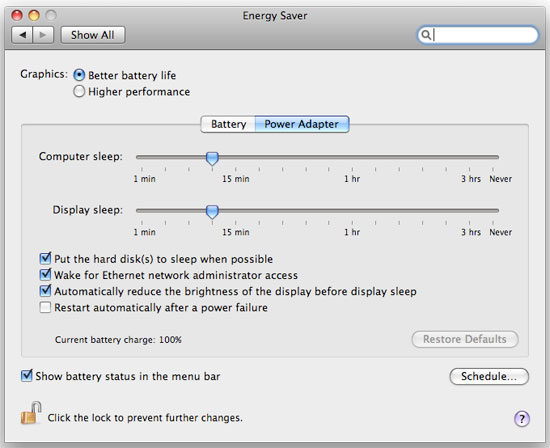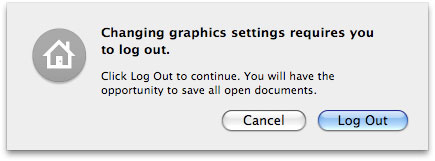Apple's Redesigned MacBook and MacBook Pro: Thoroughly Reviewed
by Anand Lal Shimpi on October 22, 2008 12:00 AM EST- Posted in
- Mac
Two GPUs
While the MacBook relies on the integrated GeForce 9400M, the MacBook Pro includes a discrete GPU as well (NVIDIA calls this a dGPU and the integrated one the mGPU): a GeForce 9600M. The 9600M features 32 SPs up from 16 in the 9400M, giving it more shader power and it's got its own dedicated frame buffer off of a 128-bit memory bus. The dedicated frame buffer is quite possibly the most important but the usefulness here is pretty much limited to games (which are mostly going to be Windows-only) and the high end professional applications that are GPU accelerated.

Apple gives you the option of switching between the two GPUs in the Energy Saver preference pane; unfortunately you have to log out and log back in to switch between the dGPU and mGPU. Other PC implementations of Hybrid Power (what NVIDIA calls the ability to turn off the dGPU and rely on just the mGPU) aren't so clumsy and can be done from within Windows, but for whatever reason Apple requires a logout/login.

The mGPU is preferable for battery life as you'll see in the section on battery life shortly.
Pulling an Apple out of a Hat: DisplayPort Standard
Apple has a tendency of doing this thing where it adopts new standards and gets rid of old ones well before their time is up. It's admirable and it allows Apple to pull off some neat tricks, but as Apple is a much larger manufacturer today than it was in the past we're starting to see examples of why companies like Dell don't take a similar approach.
Case in point is the video output on these two notebooks we're looking at today. Apple had a DVI output on its MacBook Pro but the connector itself was a little too big for the form factor changes that Apple wanted to implement. On the MacBook Air Apple used a mini DVI output, but on the new MacBook and MacBook Pro we have a mini DisplayPort connector.

The mini DisplayPort connector is to the left of the mic-input
Unfortunately only Apple uses mini DisplayPort on its recently introduced 24" display; Dell still uses the full sized DisplayPort connector on its monitors - not to mention the many more that use standard DVI or VGA.
Apple's solution is to offer mini-DP to DVI, DVI, or DL-DVI adapters, which is acceptable; unfortunately neither notebook ships with a single adapter. In the long term this will hopefully be a non-issue, but until then be prepared to spend another $30 or $100 (dual-link DVI) to support an external display.










66 Comments
View All Comments
Imaginer - Wednesday, October 22, 2008 - link
And you have the options of the new iMirror or the new iMirror! :PBut all iJokes aside, this article did not really had me until it is mentioned of the new trackpad. Initially, I thought that Apple went off the deep end by going from one button to NO buttons. But in the end, the right and left click is simply a finger or two down away from touching the pad to make the click.
It is a SHAME that Anand had many troubles with the fickleness of the pad - and even moreso in Windows. Big deal breaker (alongside the annoyance of the newly adopted displayport with no included adapter (nickel and dime? at the very least monitor manufacturers include BOTH the DVI and VGA cable with each monitor, wmy not Apple?).
Features aside, I do agree while that many (including myself) equate Apple to the USSR of the computing world, they do put together a nice OVERALL package compared to other manufacturers. Next revision Apple.... you almost had me with this one... ALMOST. Get your windows stuff and hardware support together and well talk (yes and that includes supporting ALL of your "gestures" in the Windows platform too - yeah fat chance in hell).
ltcommanderdata - Wednesday, October 22, 2008 - link
The Windows issues should hopefully be fixed with the next BootCamp driver update.But I have to agree about the glass/glossy reflectiveness. I really hope Apple brings back a matte option, which is unlikely, or at least find some way to reduce the reflectivity in the next refresh.
andreschmidt - Wednesday, October 22, 2008 - link
The first reports are coming in at MacRumors and they are definitely Samsung SSDs...didn't they use that horrible controller?Voldenuit - Wednesday, October 22, 2008 - link
"In testing the first batch of Centrino 2 notebooks that Jarred received he noted that he can't seem to find a mainstream notebook with a 50 - 60WHr battery that can come close to offering the sort of battery life you get out of the Macs."You're not looking hard enough. The lenovo thinkpad T400 registered 6.5 hrs with wireless on using a 56 WHr battery.
http://www.notebookreview.com/default.asp?newsID=4...">http://www.notebookreview.com/default.asp?newsID=4...
That's about 30% longer than the Macbook Pro.
JarredWalton - Wednesday, October 22, 2008 - link
"With the T400 you can reach 9 hours and 41 minutes with the wireless enabled, screen backlight at 60%, and the laptop in integrated graphics mode using only the 84Wh 9-cell battery. In this situation the notebook is only consuming roughly 8.5 watts of power. In dedicated graphics mode under the same settings battery life falls by exactly 2 hours down to 7 hours and 41 minutes, and power draw increases to 10.5 watts. The 6-cell battery managed 6 hours and 4 hours and 28 minutes respectively."No mention is made of actually *surfing* the web - WiFi is merely enabled. Without knowing more about how they conduct their battery life testing, I can't say whether their numbers are comparable to ours. What I do know is that on the notebook I mentioned in an earlier comment, battery life almost doubles (142 minutes vs. 261 minutes) when I go from web surfing to idle.
quanta - Wednesday, October 22, 2008 - link
The buttonless mouse is the dumbest idea. For example, if I have to press 1 finger for left click, 2 fingers on the pad for right click, how do I press both buttons? In addition, if scroll is done by moving 2 fingers, how does it not get confused with dragging with right mouse button? Furthermore, the lack of tactile feedback also reduces productivity. So much for another innovative design.aj28 - Thursday, October 23, 2008 - link
1) Why would you need to do a simultaneous left and right click?2) Why would you drag with the right mouse button? (also refer to below)
3) It DOES have tactile feedback. The whole trackpad is a depressible button...
Take your biased ideas elsewhere, thanks. Apple does good for the PC industry and provides an alternative to Microsoft-based solutions. Whether they're better or not is entirely a matter of opinion, but the bottom line is that they provide competition, and competition is good for everyone.
hb18 - Saturday, October 25, 2008 - link
Another good use of simultaneous button clicks is mouse gestures in web browsers.Johnmcl7 - Thursday, October 23, 2008 - link
1 - For pasting in *nix applications, at least that's what I use on a conventional mouse.2 - Right click drag in Windows lets you choose the file behaviour (move, copy, create shortcut) whereas a standard left click drag will just do a default action.
John
headbox - Saturday, October 25, 2008 - link
1. newflash: this isn't *nix. There's nothing preventing you from getting a mouse either.2. keyboard shortcuts are faster than mouse actions. Get to know them.